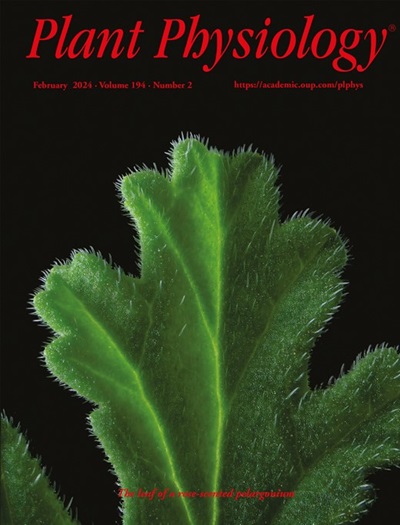Mutations in the floral regulator gene HUA2 restore flowering to the Arabidopsis trehalose 6-phosphate synthase1 (tps1) mutant
IF 6.9
1区 生物学
Q1 PLANT SCIENCES
引用次数: 0
Abstract
Plant growth and development are regulated by many factors, including carbohydrate availability and signaling. Trehalose 6-phosphate (T6P), which is synthesized by TREHALOSE-6-PHOSPHATE SYNTHASE 1 (TPS1), is positively associated with and functions as a signal that informs the cell about the carbohydrate status. Mutations in TPS1 negatively affect the growth and development of Arabidopsis (Arabidopsis thaliana), and complete loss-of-function alleles are embryo-lethal, which can be overcome using inducible expression of TPS1 (GVG::TPS1) during embryogenesis. Using EMS mutagenesis in combination with genome re-sequencing, we have identified several alleles in the floral regulator gene HUA2 that restore flowering in tps1-2 GVG::TPS1. Genetic analyses using a HUA2 T-DNA insertion allele, hua2-4, confirmed this finding. RNA-seq analyses demonstrated that hua2-4 has widespread effects on the tps1-2 GVG::TPS1 transcriptome, including key genes and pathways involved in regulating flowering. Higher order mutants combining tps1-2 GVG::TPS1 and hua2-4 with alleles in the key flowering time regulators FLOWERING LOCUS T (FT), SUPPRESSOR OF OVEREXPRESSION OF CONSTANS 1 (SOC1), and FLOWERING LOCUS C (FLC) were constructed to analyze the role of HUA2 during floral transition in tps1-2 in more detail. Our findings demonstrate that loss of HUA2 can restore flowering in tps1-2 GVG::TPS1, in part through activation of FT, with contributions from the upstream regulators SOC1 and FLC. Interestingly, we found that mutation of FLC is sufficient to induce flowering in tps1-2 GVG::TPS1. Furthermore, we observed that mutations in HUA2 modulate carbohydrate signaling and that this regulation might contribute to flowering in hua2-4 tps1-2 GVG::TPS1.花调节基因HUA2的突变使拟南芥海藻糖6-磷酸合成酶1 (tps1)突变体恢复开花
植物的生长发育受多种因素的调控,包括碳水化合物可利用性和信号转导。海藻糖6-磷酸(T6P)是由海藻糖-6-磷酸合成酶1 (TPS1)合成的,它与细胞的碳水化合物状态呈正相关,并作为信号告知细胞。TPS1突变对拟南芥(Arabidopsis thaliana)的生长发育有负面影响,而完全功能缺失的等位基因是胚胎致死性的,可以通过在胚胎发生过程中诱导表达TPS1 (GVG::TPS1)来克服。利用EMS诱变与基因组重测序相结合,我们在TPS1 -2 GVG::TPS1中鉴定出了几个恢复开花的花调节基因HUA2的等位基因。使用HUA2 T-DNA插入等位基因HUA2 -4的遗传分析证实了这一发现。RNA-seq分析表明,hua2-4对TPS1 -2 GVG::TPS1转录组具有广泛的影响,包括调控开花的关键基因和途径。通过构建高阶突变体GVG::TPS1和HUA2 -4与开花时间关键调控基因开花位点T (FT)、过表达抑制基因SOC1 (SUPPRESSOR OF OVEREXPRESSION OF CONSTANS 1)和开花位点C (FLC)等位基因的组合,详细分析了HUA2在TPS1 -2花期转化中的作用。我们的研究结果表明,HUA2的缺失可以恢复TPS1 -2 GVG::TPS1的开花,部分是通过激活FT,上游调节因子SOC1和FLC也有贡献。有趣的是,我们发现FLC突变足以诱导TPS1 -2 GVG::TPS1开花。此外,我们观察到HUA2的突变调节了碳水化合物信号,这种调节可能有助于HUA2 -4 TPS1 -2 GVG::TPS1的开花。
本文章由计算机程序翻译,如有差异,请以英文原文为准。
求助全文
约1分钟内获得全文
求助全文
来源期刊

Plant Physiology
生物-植物科学
CiteScore
12.20
自引率
5.40%
发文量
535
审稿时长
2.3 months
期刊介绍:
Plant Physiology® is a distinguished and highly respected journal with a rich history dating back to its establishment in 1926. It stands as a leading international publication in the field of plant biology, covering a comprehensive range of topics from the molecular and structural aspects of plant life to systems biology and ecophysiology. Recognized as the most highly cited journal in plant sciences, Plant Physiology® is a testament to its commitment to excellence and the dissemination of groundbreaking research.
As the official publication of the American Society of Plant Biologists, Plant Physiology® upholds rigorous peer-review standards, ensuring that the scientific community receives the highest quality research. The journal releases 12 issues annually, providing a steady stream of new findings and insights to its readership.
 求助内容:
求助内容: 应助结果提醒方式:
应助结果提醒方式:


